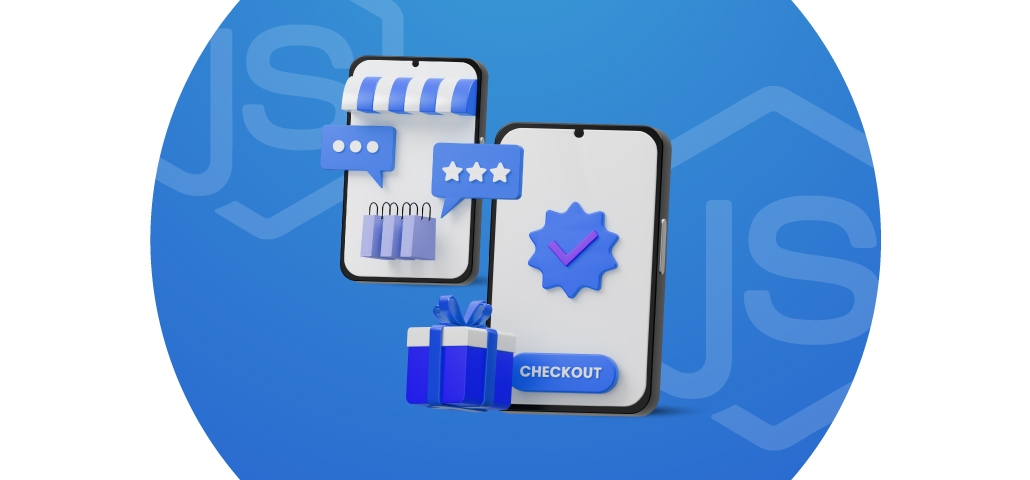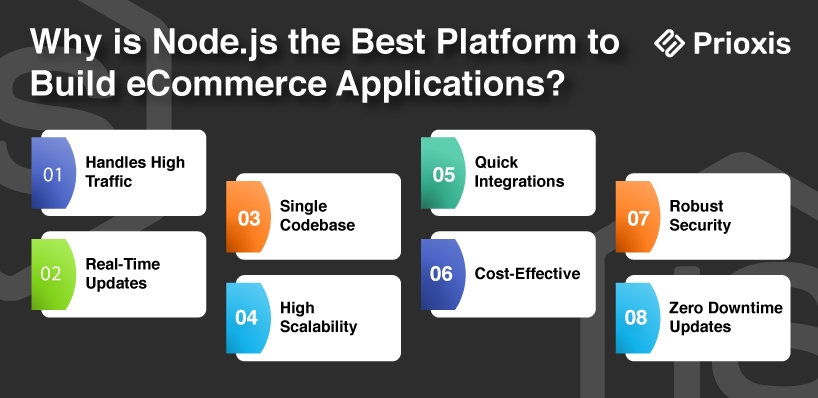
Table of Content

Arjun Bhatt
Arjun is a passionate full-stack developer specializing in modern JavaScript frameworks and technologies. With deep expertise in React, Next.js, and Node.js, he has spent years crafting intuitive user interfaces and scalable web applications that deliver exceptional user experiences across both frontend and backend development.
In 2009, Ryan Dahl created Node.js, a tool that lets developers use JavaScript for server-side programming, not just for the front end. This was a big change because JavaScript had mainly been used to build websites, not the backend.
Node.js revolutionized backend development by providing a non-blocking, event-driven architecture that allowed for faster, more scalable applications. Today, many developers use Node.js to build fast, high-performing web applications, especially for real-time apps and eCommerce websites.
Node Doubt About It: The Stats Behind the rise of Node.js development
That said, building a Node.js E-commerce app can be challenging. Here are some node.js best practices to help make it easier. We’ll cover everything from setting up your project to adding key features like a shopping cart and payment options.
But first, let’s understand -

eCommerce app development requires high performance, scalability, and real-time capabilities. Node.js, a JavaScript runtime, has become one of the top choices for developers working on such applications. Here’s why:
Whether it’s Black Friday or a flash sale, Node.js is built to keep your site running smoothly when it matters most. Unlike traditional platforms that struggle under heavy traffic, Node.js can handle thousands of users browsing and purchasing at the same time without slowing down. This means less downtime and fewer lost sales during peak periods.
Let your customers get real-time updates on stock availability or order statuses without refreshing the page. Node.js makes this easy to implement. For example, if a product goes out of stock, your customers will know instantly, preventing frustration. Or you could offer live chat support that responds in real-time, helping users make faster buying decisions.
Node.js uses JavaScript for both the frontend and backend, which means your developers can work faster using the same language across the whole application. This reduces development time and lowers costs. For your business, it means quicker launch times and easier maintenance as your platform grows. No more back-and-forth between frontend and backend development specialists—everything is streamlined.
Starting small but planning to scale? Node.js is ideal for eCommerce solutions that need to grow quickly. For example, if you want to add a recommendation engine, loyalty program, or integrate third-party services like payment gateways or shipping APIs, Node.js makes scaling easy without needing a complete rebuild. The platform grows as your business grows.
With Node.js, you don’t have to spend weeks custom-coding basic but essential features like payment gateways (Stripe, PayPal) or shipping integrations (FedEx, DHL). Thanks to Node's vast library of modules, you can integrate these services in hours, not days. It’s a time-saver that gets you to market faster, so you can focus on differentiating your ecommerce website and mobile application development.
Node.js is designed to handle more users with fewer resources. Instead of paying for expensive server upgrades as traffic grows, Node.js allows you to handle more customers without overloading your servers. This efficiency translates directly to lower operating costs as your business expands, making it ideal for ecommerce startups and businesses operating on tight margins.
For eCommerce business, security is non-negotiable. Node.js comes with powerful security tools, like encrypted connections and secure authentication (e.g., using JWT or bcrypt for passwords). Your customers can trust that their data is safe when making purchases, which reduces the risk of data breaches or fraud. PayPal and other major players rely on Node.js for this very reason.
Need to launch a new feature or fix an issue? Node.js lets you push updates quickly without taking the entire site down. Whether it's introducing a new product category or adjusting the checkout flow, you can make these changes smoothly, keeping your customers happy and your business running.
Let’s get started and see how to build an eCommerce app step by step!
Planning your app’s structure, features, and tools is the foundation of your project.
Clear planning ensures you cover all necessary features, like product listings, user accounts, shopping carts, and payments. It also helps you choose the right technology stack. or an eCommerce app, your essential features will include product pages, user login, a checkout system, and an admin dashboard to manage products. Use Node.js for the backend, Express as your web framework, and MongoDB for your database. For the front end, you can choose a framework like React. Follow the Model-View-Controller (MVC) pattern to keep your app modular and maintainable.
ecommerce-site/ ├── config/ │ └── db.js ├── controllers/ │ ├── authController.js │ ├── productController.js │ └── orderController.js ├── models/ │ ├── User.js │ ├── Product.js │ └── Order.js ├── routes/ │ ├── authRoutes.js │ ├── productRoutes.js │ └── orderRoutes.js ├── middleware/ │ └── authMiddleware.js ├── .env ├── app.js
This is where you create the structure of your Node.js app and install necessary tools.
Setting up the environment properly makes it easier to develop, test, and maintain your codebase.
# Create a new project folder mkdir ecommerce-site cd ecommerce-site # Initialize a Node.js project npm init -y # Install required packages npm install express mongoose bcryptjs jsonwebtoken stripe dotenv nodemailer npm install --save-dev nodemon
This step involves designing how you’ll store and organize your app’s data, such as products, users, and orders. A well-structured database ensures efficient data retrieval and easier scaling as your app grows.
Create a "Products" collection in MongoDB with fields like product name, price, category, stock, and images. Similarly, set up a "Users" collection that includes fields for username, email, and password.
Users: User profile, authentication (e.g., name, email, password).
Products: Name, description, price, stock, categories, and images.
Orders: User, products, quantity, total price, status (e.g., pending, shipped).
Cart: User session-based cart that stores items until checkout.
MongoDB Connection Setup:
const mongoose = require('mongoose');
const connectDB = async () => {
try {
await mongoose.connect(process.env.MONGO_URI, {
useNewUrlParser: true,
useUnifiedTopology: true,
});
console.log('MongoDB connected');
} catch (error) {
console.error('Database connection failed:', error);
process.exit(1);
}
};
module.exports = connectDB;
Why do it? To connect to MongoDB, use Mongoose, a library that helps manage database schemas and queries easily.
Create a .env file to store sensitive credentials:
MONGO_URI=mongodb://localhost:27017/ecommerce
JWT_SECRET=your_jwt_secret
STRIPE_SECRET_KEY=your_stripe_key
For Server Setup: Create an Express server to handle incoming requests.
Why do it? The server is the backbone of your app, routing requests and handling responses.
Server Setup:
const express = require('express');
const dotenv = require('dotenv');
const connectDB = require('./config/db');
dotenv.config();
connectDB();
const app = express();
app.use(express.json());
app.use('/api/auth', require('./routes/authRoutes'));
app.use('/api/products', require('./routes/productRoutes'));
app.use('/api/orders', require('./routes/orderRoutes'));
const PORT = process.env.PORT || 5000;
app.listen(PORT, () => console.log(`Server running on port ${PORT}`));
nodemon server.js
This allows users to create accounts and securely log in, providing them access to features like viewing their orders or saving items in their cart. Secure user authentication protects sensitive data and personalizes the shopping experience for customers.
Use JWT (JSON Web Tokens) to handle user sessions. When a user logs in, generate a token that’s stored client-side, allowing users to remain logged in while browsing the app. For password security, use bcrypt to hash passwords before saving them to the database. Role-based access implements admin privileges for product management and order tracking and OAuth integration is used for optional integration with Google, Facebook, or other OAuth providers for social login.
const mongoose = require('mongoose');
const bcrypt = require('bcryptjs');
const userSchema = new mongoose.Schema({
name: { type: String, required: true },
email: { type: String, required: true, unique: true },
password: { type: String, required: true },
role: { type: String, enum: ['customer', 'admin'], default: 'customer' },
});
userSchema.pre('save', async function (next) {
if (!this.isModified('password')) return next();
this.password = await bcrypt.hash(this.password, 10);
next();
});
userSchema.methods.matchPassword = async function (password) {
return await bcrypt.compare(password, this.password);
};
module.exports = mongoose.model('User', userSchema);
Authentication Middleware:
Middleware restricts access to certain routes to ensure that only logged-in users can access restricted features.
Auth Middleware:
const jwt = require('jsonwebtoken');
const User = require('../models/User');
const protect = async (req, res, next) => {
let token;
if (req.headers.authorization && req.headers.authorization.startsWith('Bearer')) {
token = req.headers.authorization.split(' ')[1];
}
if (!token) {
return res.status(401).json({ error: 'Not authorized' });
}
try {
const decoded = jwt.verify(token, process.env.JWT_SECRET);
req.user = await User.findById(decoded.id);
next();
} catch (err) {
res.status(401).json({ error: 'Not authorized' });
}
};
module.exports = { protect };
Routes handle user registration and logic. These routes allow users to register and log in to the app.
Auth Routes:
const express = require('express');
const { register, login } = require('../controllers/authController');
const router = express.Router();
router.post('/register', register);
router.post('/login', login);
module.exports = router;
Authentication Controller
It handles the logic for user registration and login, separating business logic from routing.
const User = require('../models/User');
const jwt = require('jsonwebtoken');
const register = async (req, res) => {
const { name, email, password } = req.body;
try {
const user = await User.create({ name, email, password });
const token = jwt.sign({ id: user._id }, process.env.JWT_SECRET);
res.status(201).json({ token, user: { id: user._id, name: user.name, email: user.email } });
} catch (err) {
res.status(400).json({ error: err.message });
}
};
const login = async (req, res) => {
const { email, password } = req.body;
try {
const user = await User.findOne({ email });
if (!user || !(await user.matchPassword(password))) {
return res.status(401).json({ error: 'Invalid credentials' });
}
const token = jwt.sign({ id: user._id }, process.env.JWT_SECRET);
res.status(200).json({ token, user: { id: user._id, name: user.name, email: user.email } });
} catch (err) {
res.status(400).json({ error: err.message });
}
}; module.exports = { register, login };
This involves creating, reading, updating, and deleting products from your inventory, also known as CRUD operations.
Your app needs a way to display products to users, and admins need tools to manage the inventory.
Set up routes in Express to handle product management. Admins can use POST routes to add new products and PUT routes to update product details, while users can GET product listings and filter them by category or price.
This feature allows users to select products and proceed with a secure purchase through a payment gateway. An eCommerce app is incomplete without a reliable shopping cart and payment system that can handle multiple items, calculate totals, and process payments.
Use session-based or token-based storage to keep track of the user’s cart. When a user adds an item, the app updates their cart in the session. For checkout, integrate Stripe or PayPal by using their SDKs to process credit card payments securely.
This step handles storing the order details once payment is confirmed, updating stock levels, and allowing users to track their purchases. Proper order management system ensures inventory stays accurate and gives users a seamless experience from cart to delivery.
After a successful payment, create an order entry in the database with details such as user info, products purchased, and order status (e.g., pending, shipped). Use webhooks from your payment gateway to confirm payment and trigger stock updates automatically.
A payment gateway processes user payments securely and ensures compliance with financial regulations. Without a secure and compliant payment gateway, your app cannot process transactions, which is crucial for an eCommerce platform.
Stripe and PayPal are widely used options. Install their SDKs, and use their APIs to handle credit card payments, ensuring you adhere to PCI compliance. For example, in Stripe, use stripe.createPaymentMethod() to securely capture payment details.
This feature lets users search for products and apply filters like price range or categories. A good search and filter system improves user experience by helping them find exactly what they need without scrolling through endless lists.
Use MongoDB’s full-text search to enable keyword-based product search. Combine this with query filters like price or category and paginate the results to improve performance and usability.
This includes measures to protect your app from hacking attempts and ensure safe data handling. eCommerce apps deal with sensitive information, so following security practices is essential to protect user data and avoid breaches.
Use bcrypt to hash passwords before storing them in the database, and ensure your app uses HTTPS to encrypt all communications. Sanitize user input to prevent SQL injection and other common attacks and set up Cross-Site Request Forgery (CSRF) protection to secure forms.
This involves sending users emails for things like order confirmations, password resets, and shipping updates. Email notifications keep users informed and add a professional touch to your eCommerce platform.
Use a service like Nodemailer to set up email notifications. After an order is placed, trigger an email to the user with their order summary, estimated delivery date, and a link to track the status of their shipment.
A control panel where admins can manage products, orders, users, and view analytics. A well-built admin dashboard gives business owners control over their store and helps them manage operations efficiently.
Build a dashboard using a frontend framework like React or Vue.js, where admins can log in, view sales reports, and manage the product catalog. Add features like order status updates, inventory tracking, and user management
Testing ensures that all parts of your app work as expected, both individually and together. Catching bugs early through testing saves time and ensures your app provides a smooth experience for users.
Write unit tests for key functions, like user login or checkout, using tools like Mocha or Jest. Integration tests can ensure that the payment process, order creation, and user authentication work together without issues.
This is the process of putting your app online so users can access it. Once the app is complete, deployment allows customers to use your platform in a live environment.
Deploy your Node.js app on Heroku, AWS, or DigitalOcean. Use services like MongoDB Atlas for database hosting. Set up CI/CD pipelines with tools like GitHub Actions to automate updates and reduce downtime.
This involves making sure your app loads quickly and can handle many users at once or even under heavy traffic by improving loading times and server response. Slow apps can frustrate users, and unresponsive apps can lead to poor user experience and lost sales.
Use Redis to cache frequently accessed data like product details or user sessions. Enable MongoDB indexing on fields like product names to speed up searches. Also, consider using a load balancer to distribute traffic across multiple servers if your app sees heavy traffic.
Analytics allow you to track how users interact with your app and measure things like sales and user behavior. Monitoring analytics helps you understand how users are interacting with your app and where improvements are needed.
Integrate Google Analytics or a similar tool to monitor traffic, product views, and sales conversions. Use this data to optimize user experience, identify drop-offs, and fine-tune your marketing strategy.
Use custom metrics to monitor events like "add to cart" and "checkout abandonment" to optimize your sales funnel.
Node.js is the ideal platform for building eCommerce applications because of its ability to handle large-scale, real-time interactions, its efficient performance, and its ease of use with modern development practices. Whether you're building a startup eCommerce site or scaling an existing one, Node.js provides the tools and flexibility to create a fast, secure, and scalable solution.
Known for its excellent performance and stability, it’s a reliable choice for developing online stores. The platform’s cost-effectiveness, combined with a large and active developer community, has made Node.js increasingly popular in the eCommerce industry.
The wide range of pre-built frameworks also simplify the development process, allowing for faster project execution. However, with Node.js being in high demand, finding skilled Node.js developers with the right experience can be a challenge, especially depending on local market conditions. Having a capable team to manage the project from start to finish is essential.
At Prioxis, we can help you overcome these challenges. If you're looking for experienced Node.js developers, don’t hesitate to reach out. Whether your project is simple or complex, we’re here to turn your vision into reality.
Get in touch